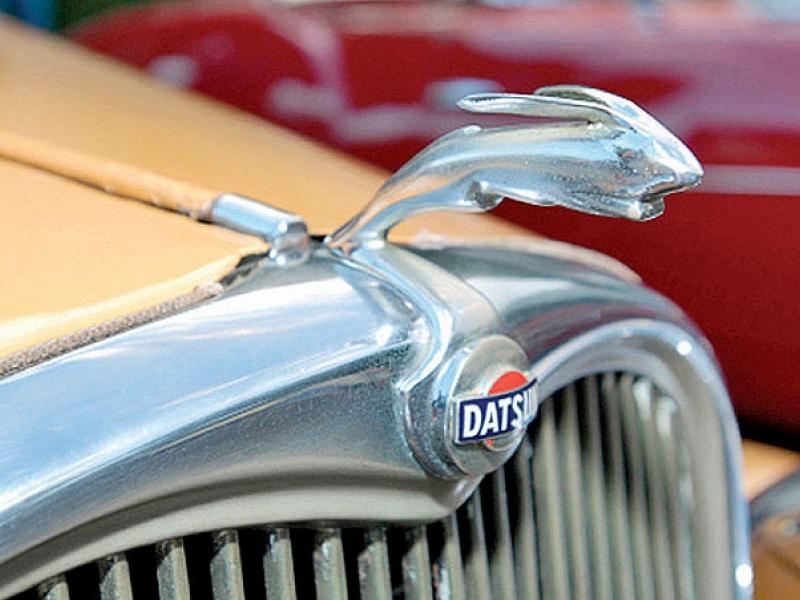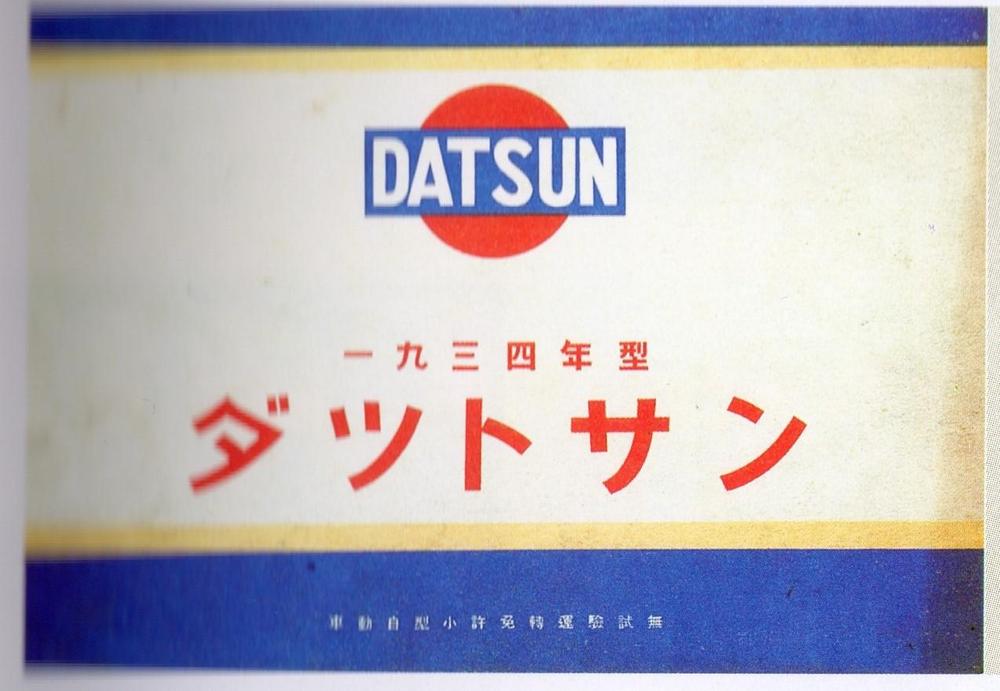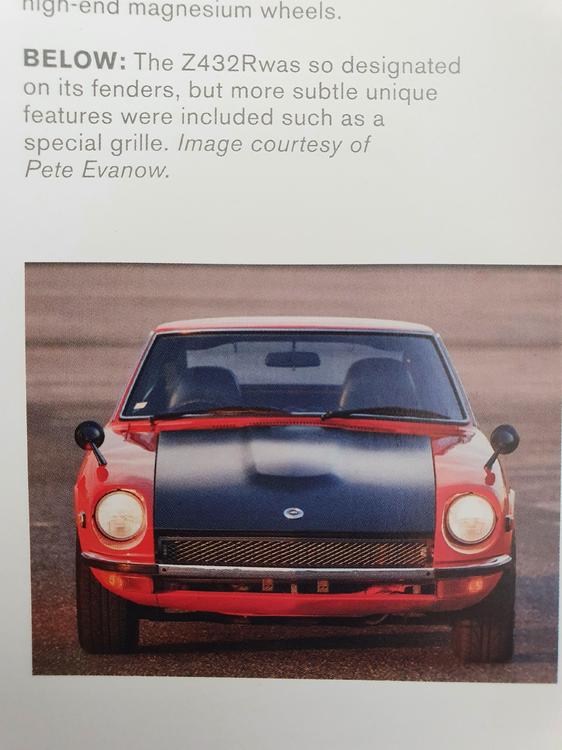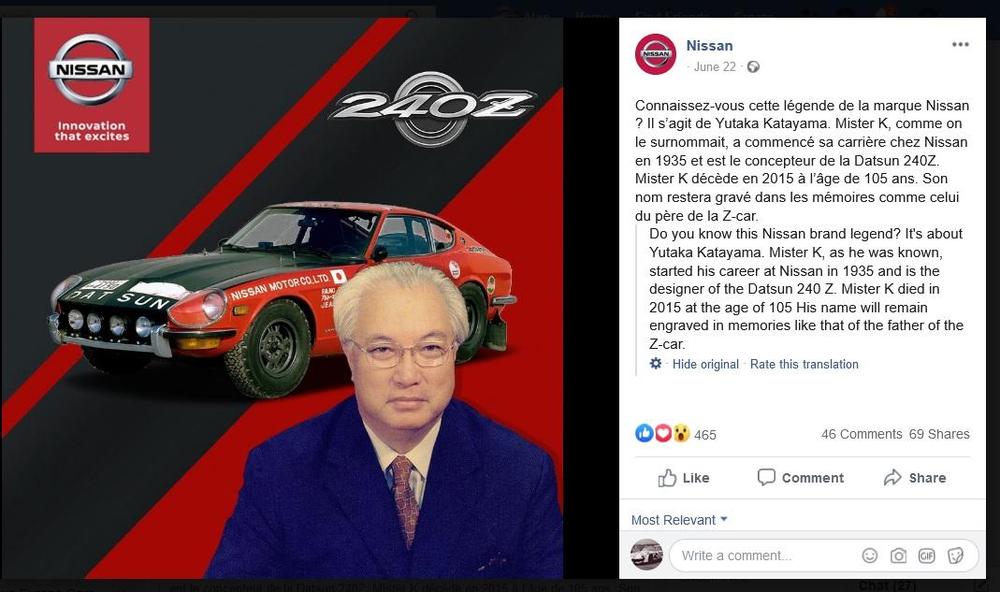Everything posted by HS30-H
-
Nissan Z: 50 Years of Exhilarating Performance
Page 16: "Hashimoto took three years to build his first vehicle, a two-cylinder, 10-horsepower car he called the "Dat". The name derived from the initials of his three supporters. Dat also means "hare" in Japanese, reflecting the vehicle's presumed speed and craftiness." Here's a classic case of copying the mistakes of others. The Japanese word for the common Hare is 'Nousagi' (literally, 'Field Rabbit'). The running hare emblem on some of the early Datsun products: This is not 'a Dat'. In Japanese, the word which can be Romanised as 'Dat' (phonetically 'Da-tto') is a verb. Here's the Japanese dictionary again: ...so the emblem uses the wild Hare as a symbol of speed and agility (whilst still being fairly modest) and it is not 'a Dat'.
-
Nissan Z: 50 Years of Exhilarating Performance
Page 16: "....but in 1911, US-educated Masujiro Hashimoto began the Kwaishinsha Motor Company in Tokyo." There was never any company called 'Kwaishinsha'. It was 'Kaishinsha'. Here's the original Kanji: 快進社
-
Nissan Z: 50 Years of Exhilarating Performance
Page 71: "The red, white and blue Datsun logo and brand reflected a fusion of Japanese heritage (the rising sun) with American patriotism". What...?! How on earth was that logo anything at all to do with "American patriotism"? This is almost a cargo cult level of nonsense. They say that 'man created God in his own image', but here's America seeing itself reflected in something that has nothing to do with it. Bonkers. Here's a Nissan Jidosha KK 'Datsun' brochure from 1934. I think its a fairly sure bet that Nissan didn't come up with their new 'Datsun' logo's colouring as any kind of hat tip to the USA:
-
Nissan Z: 50 Years of Exhilarating Performance
I've been dipping into this new book occasionally over the last few days, and I have to say it is right up there. Right up there with the worst. Its really, really poorly put together. In fact, I'm not even sure what it is supposed to be? It's not a 'history' type book. It doesn't bring anything new to the table in that respect, and - indeed - perhaps it is not even trying to be? It seems to be more of a typical coffee table book, an accumulation of Nissan's stock press images with blocks of text filling in the gaps and chapter headings which don't necessarily have much relation to their content. Example: Leafing through a chapter titled 'The 50th Anniversary Z', you'll suddenly come across a photo of a Nissan Figaro, on Thailand license plates (?!), taking up a full page. Why? Well, apparently it illustrates the talent of Nissan's designers. Now, the products of Nissan's 'PIKE' studio in the late 80s and early 90s are an interesting and worthy topic in their own right, but how do they relate to this book, and to this particular chapter of the book? The photo caption states the Figaro was "...primarily a Japan-only vehicle." In fact it was solely a Japanese market vehicle, never intended for official export. Ironic that the concept, creation and marketing of the Figaro as a Japan-only vehicle is apparently not questioned when, just a couple of chapters previously, the author is apparently unable to imagine the CSP311 Silvia as anything other than some kind of USA-focused 'test'. So what is this book? Perhaps the main clue is that it is being endorsed as a NISSAN MOTOR CORPORATION 'Official Licensed Product'. I guess it fills what would otherwise be a gap in the marking/marketing of the '50th Anniversary', an English-language American take on five decades worth of product in a time when what comes next is still somewhat unclear. So, perhaps I should view it as 32 Pounds Sterling (42 US Dollars) worth of advertorial? I might be tempted to use it as a fancy drinks coaster...
-
Nissan Z: 50 Years of Exhilarating Performance
The more I look at Chapter 7 - titled "The Car Hobby Culture" (???) - the more bizarre it gets. There's a section headed 'The Limited-Run Silvia And Its Z Connection'. It's about the CSP311 Nissan Silvia of 1964, and Mr Evanow credits it to Albrecht Goertz. In fact it was styled in-house at Nissan by Kazuo Kimura before Goertz got anywhere near it. Kimura doesn't get a name check. Poor research there, but it gets worse: Page 121: "...a two-door hardtop said to be based off the Fairlady convertible..." "Said to be"? The clue is in the chassis code. CSP311. It was built around the chassis and running gear of the SP311 Fairlady. There's no "said to be" about it. Page 121: "Because of its uniqueness in the marketplace, the Silvia carried the Nissan name rather than Datsun." What does this actually mean? It doesn't make any sense. Page 121: "...the two-door, short-wheelbase coupe could very well have been the starting point for the Z". No. But it gets worse: Page 121: "There are plenty of doubters, but why would NMC-USA go to so much effort to essentially hand-build approximately 550 units, only to test the market for such a hardtop?" What?! Is this a typo or something? What on earth did NMC-USA have to do with the CSP311? The author is making it sound like the CSP311 could not have existed without being some kind of 'test' for a USA-targeted product. No apparent regard for what such a prestige, coachbuilt item might mean to Nissan and - by extension - the Japanese people themselves. It was a statement, a demonstration. Japanese styling on contemporary mechanicals, craftsman-built by the artisans at Tonouchi and arguably a match for anything else from the rest of the world in 1964. Why is a production run of 500+ being framed as some kind of 'failure'? Auto manufacturers have been doing this kind of thing since the beginning. There is absolutely NO reason to view it solely through the lens of the United States, or as anything other than what it was. The CSP311 was a success in its own right, an elegant and refined product with some exquisite attention to detail and a match for anything being turned out by the big Italian styling houses of the time. Recommendation: If anyone is interested in the deeper story of the CSP311 and its genesis, please take a look at Ian Patmore's excellently researched website csp311.net https://csp311.net/csp311-development-history/
-
Nissan Z: 50 Years of Exhilarating Performance
I'm scratching my head wondering how some of this stuff gets written in the first place, let alone get past an editor or proof reader. Page 117: "Initially, the Z had few export sales other than the US. According to Carl Beck, the only other countries that received Zs in the early '70s were Australia, New Zealand and the UK." This would be a surprise to France, Holland, Germany, Belgium and Portugal - as well as several other nations - which received HLS30 model Datsun 240Zs during the 1970 through 1973 period. Page 117: "Zs in Japan of course received a smaller engine, due to taxation issues established by the government." Apart from the ones that got an L24, right? Japan got three distinct L24-engined models, available from late 1971 through to the end of 1973. Page 120 mentions the 'Fairlady 240ZG', but not the fact that it had an L24 engine. There's a photo of an HS30-H model Fairlady 240ZG on Page 121 ('Fairlady 240Z' emblems plain to see), although it is captioned as a 'Fairlady ZG' (?). Page 118: "Zs also seemed to earn a five-speed in Japan before any other country, the overdrive offering fuel economy, especially important as gas prices always exceeded those in the US. This was either a luxury option or was unavailable in export markets for many years, to the dismay of legions of American drivers". Was this written by a car guy? The overdrive 5-speeds were a performance-related feature, being close ratio and using Servo synchros, and being linked to a matching differential ratio. The whole point was about having 4 closely-spaced gears for sporty driving with a 3.9:1 (or 4.44:1) diff ratio, but with the overdriven fifth for longer-legged cruising when necessary. Economy was a secondary concern. And ALL export markets - except North America - got the 5-speeds as standard equipment from the beginning of sales. Japan had model variants with both 5 and 4-speeds from the beginning of sales. North America was odd one out here. I think one of the symptoms of lack of comprehension with regard to the structure of the S30-series Z range is demonstrated on Page 118: Page 118: "One of the real collectibles among early 240Zs remains the Z432". As I've said many times, if you don't understand that the S30-series Z was a family of variants from the beginning, then you'll never fully understand each individual variant.
-
Nissan Z: 50 Years of Exhilarating Performance
Pages 119 and 120 carry photos of a car that is captioned as being a 'Z432R'. P119 caption tells us that "The Z432R was so designated on its fenders...", but this is not true. The 432-Rs were fitted with exactly the same 'Nissan', Fairlady Z' and '432' emblems as the standard 432 models. In fact the car in the photographs (credited to Pete Evanow) is a PS30 model Fairlady Z432 with a satin black-painted bonnet. It is not a PS30-SB model Fairlady Z432-R. This particular car has passed through more than one pair of hands whilst in the USA, once at auction, and is well known. I cannot understand how it is being confused with a genuine 432-R model.
-
Nissan Z: 50 Years of Exhilarating Performance
Page 118 shows a (Nissan stock) photo of a car which is in their Heritage Collection at Zama. It's a 1977 CS31-D model Fairlady Z-L 2-seater. And yet the photo caption tells us it is a "280Z-L" and that it had "...ventilated discs in the front and discs in the rear". The adjacent paragraphs talk about a "Fairlady 280Z-L" (once again with ventilated discs on the front and discs on the rear) and also a "Fairlady 280Z-T" No stock S30/S31-series car had ventilated discs on the front and discs on the rear, and the L28 engine was not fitted to the Japanese market S30/S31-series cars. You have mixed up S30/S31-series cars with S130-series names and equipment.
-
Nissan Z: 50 Years of Exhilarating Performance
Sorry, but that doesn't follow. I've bought your book (as I did with your previous tome) and I am perfectly entitled to give my opinion on it. Apparently (and you might want to double check this...) top-selling music album this week in the USA - according to Billboard - is a Korean 'group' called 'NCT 127' with their second album. Now, I can't dance, can't sing in tune any more and certainly don't look like any kind of sculpted plastic pop star any more, but I can tell you that - in my opinion - NCT 127's music and 'act' is pure, manufactured garbage of the first order. Do I need to start my own band in order to qualify that opinion? No, I think not. I will, however, volunteer to proof read and sub-edit your next book (The Big Double Nickel?), as it looks like you could use the help.
-
Nissan Z: 50 Years of Exhilarating Performance
Datsun was a 'brand' just about everywhere in the world at the time, but it is irrelevant to the point. The people making the presentation of the new product were working for Nissan Motor Co. in USA and the product itself was made by Nissan Motor Co. of Japan. Unthinking devotion to the 'Datsun' brand is part of the problem here. If you're the Datsun way inclined, perhaps you can explain for me the inclusion of a 'Datsun Z432' and a 'Datsun Z432R' in the book? No such-named models existed. You have the book, I take it? Oh, and you swerved the first point. Noted.
-
Nissan Z: 50 Years of Exhilarating Performance
Two points here. First, do you think it is accurate to describe the Pierre Hotel event as a 'formal introduction' without specifically mentioning that this was a press-and-dealers preview, not for the general public, and had been preceded by the Tokyo, Ginza event which took place on the 18th and 19th? Secondly, how could 'Datsun' introduce a car? 'Datsun' was a badge. The company doing the introducing at the Pierre Hotel was 'Nissan Motor Company in USA' and the car was a product of 'Nissan Motor Co. Japan'.
-
Getting it wrong with NISSAN GLOBAL
Another example. This one has been going on for years and I simply cannot understand why nobody goes back to research it from the source material. Probably a case of a mistake being repeated enough times for it to become laid down like sedimentary rock. There was never any company called 'Kwaishinsha'. It was 'Kaishinsha'. Here's the original Kanji: 快進社 https://www.nissan-global.com/EN/COMPANY/PROFILE/HERITAGE/HISTORY/
-
Nissan Z: 50 Years of Exhilarating Performance
I've got the preceding 'Z - 35 Years of Nissan's Sports Car" (from 2005) and the new book could well be published with the blurb "15 More Years Of Mistakes". ?
-
Nissan Z: 50 Years of Exhilarating Performance
I think the 'research' on this particular aspect of the story appears to have been confined to visiting zhome.com for Carl's - ahem - slightly "Made For The USA" take on history. I'll be surprised if there's any coverage of the October 18th and 19th Ginza, Tokyo HQ activities on zhome.com, and its not because its any big mystery. We've discussed it here many times, and for the same reasons.
-
Nissan Z: 50 Years of Exhilarating Performance
I'd like to introduce you to the term 'Formal Introduction', as it appears you have not met.
-
Getting it wrong with NISSAN GLOBAL
Here's some press content from an official Nissan page on Facebook. The original was written in French, but the version I first saw was identified as coming via Nissan BeNeLux (Belgium, Netherlands, Luxembourg). So Yutaka Katayama was an automotive "Designer"...? I presume he must have squeezed that particular job in between his time as a pinch hitter for the LA Dodgers, and providing the voice for Scooby Doo in the popular Hanna-Barbera cartoon series 'Scooby Doo, Where Are You?'. Not to mention his popular cookbooks... Seriously, who writes this stuff? Worse, who sub-edits it? What's happening to Nissan?
-
Nissan Z: 50 Years of Exhilarating Performance
I see the new book repeats the oft-repeated mistruth about the Z's "debut": "Datsun formally introduced the car in New York City on October 22nd, 1969, following that with its Los Angeles debut two days later with the same car." In fact, Nissan had formally introduced the S30-series Z range (not just one variant...) to invited press, dealers and key suppliers at their Ginza, Tokyo head office and showroom on October 18th and 19th 1969, as a preview of the new cars before the general public would see them at the opening of the Tokyo Motor Show. How does the New York Pierre Hotel event on the 22nd trump the Tokyo Ginza showroom event on the 18th? Both were private, invitation-only events for the same types of attendees. If the Pierre Hotel event counts as significant, then so should the Tokyo, Ginza event. And the Tokyo, Ginza event happened FIRST. The REAL debut - the public debut - of the new S30-series Z range was on 24th October 1969, at the Tokyo Motor Show. Over the course of two weeks more than 1.5 million visitors would pass through its doors:
-
Another 1972 240Z Vintage Z Program Car up for Auction on BaT
You're an 'Lstepp4re' fan club member then? ? It must be you that's sending him all the DMs about "significant Z movements", LOL. I didn't see any pond-crossing pissing match (what did I miss?) but I did witness Lstepp4re once again actively bidding up a car he had no intention of buying, attempting to control the narrative in the comments during the auction as well as threatening legal action against somebody (a fellow American) who simply disagreed with him. Bring-a-Trailer mods hit the delete button a few times and it was all swept neatly under the carpet. Maybe I'm in the minority in being allergic to superannuated, arriviste blowhards and their fanbois?
-
Another 1972 240Z Vintage Z Program Car up for Auction on BaT
Doesn't seem particularly high to me. What am I missing? I got the impression a lot of the people tuning in to that auction were expecting much more. Covid effect? You'd have a hard time getting a professional restoration to the same standard on a donor car, and that's without all the VZ kudos/baggage (delete to your taste) which should lift it above a like-for-like otherwise non-VZ example. Looked well bought to me. Lovely honest example of a VZ car. Oh, and the self-certificating BAT "Collectors" are starting to look like they are outgrowing their pool. When 'LStepp4re' is being talked up as a "expert" (tee hee) you know its all getting a bit too incestuous...
-
COVID-19
How does being "effeminate" (in your opinion) have a negative impact on his work?
- Won't go into gear
- Won't go into gear
-
correct suspension black
Given that many of the component parts on these cars were made by different companies and/or affiliates of Nissan and Nissan Shatai, I would not necessarily expect them all to have been painted with exactly the same material, or to the same standard/thickness/sheen.
-
Mint '71 240Z - More Fun Coming to BaT
If that were the case, then why did it stop at Katayama? Why not with, for example, Hajime Suitsu, Teiichi Hara or - going all the way "higher up" - Kawamata himself. I'll tell you why. It's because the people believing that Katayama was a 'Designer'/'Creator' had probably never heard of Suitsu, Hara or Kawamata, let alone the likes of Hitoshi Uemura. They appear to have simply pinned it on the face they knew. A little reminder: You revived a thread that had been dormant for a month to quote a post that I made on 20th January. On the contrary, I'll always be ready to discuss this kind of topic and I consider that a Vital Sign for a vibrant, scholarly, inquisitive and - more to the point - so far undead marque/model forum.
-
Series-One Z sells for Record Breaking $310,00 USD
Yes, I know what an Ishihara Test looks like. Thanks. In the meantime, I appear to have developed some form of vertically-stacked double vision...











